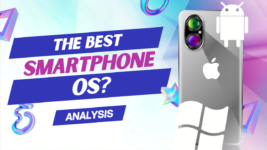

The Best Smartphone Operating Systems? Analysis!
In today’s fast-paced digital landscape, choosing the right smartphone operating system (OS) is more crucial than ever. Whether you’re a college student, a working professional, or a tech enthusiast, your smartphone’s OS can significantly impact your daily life. This article delves deep into the unique features, benefits, and pros and cons of different smartphone operating systems, helping you make an informed decision about the best OS for your needs.
Understanding the Importance of Smartphone OS
Before we dive into the specifics of each OS, it’s essential to grasp the significance of your smartphone’s operating system. The OS acts as the backbone of your device, influencing its performance, security, and overall user experience. Let’s explore the USPs, benefits, and reliability of some popular smartphone operating systems and compare last year’s updates with this year’s improvements.
Android – Versatile Customization
Android, developed by Google, is renowned for its versatility. One of its standout features is the extensive customization it offers to users. Whether you’re tweaking your device’s interface, adjusting app permissions, or installing custom ROMs, Android lets you personalize your smartphone like no other OS.
Best For: Users who love customization and a wide variety of app choices.
Pros:
- Wide range of device options.
- Extensive app library on the Google Play Store.
- Highly customizable interface.
Cons:
- Security can be a concern with various app sources.
- Updates may vary depending on the manufacturer.
iOS – Seamless Apple Ecosystem
For those deeply entrenched in the Apple ecosystem, iOS is the go-to choice. Apple has mastered the art of creating a seamless user experience across all its devices. With iOS, you can effortlessly sync your iPhone, iPad, Mac, and Apple Watch, ensuring a consistent and intuitive user experience.
Best For: Apple enthusiasts who own multiple Apple devices.
Pros:
- Seamless integration with other Apple products.
- Regular and timely updates.
- Strong focus on privacy and security.
Cons:
- Limited customization compared to Android.
- Limited device options.
HarmonyOS – Ecosystem Integration
HarmonyOS, developed by Huawei, prioritizes ecosystem integration. It simplifies device connections and control within the Huawei ecosystem, making it an excellent choice if you own multiple Huawei devices. This seamless integration can enhance your productivity and connectivity.
Best For: Huawei device owners looking for a unified ecosystem.
Pros:
- Seamless connectivity across Huawei devices.
- Fast and efficient performance.
- Cross-device collaboration.
Cons:
- Limited app availability compared to Android and iOS.
- International availability may vary.
KaiOS – Smart Simplicity
KaiOS is all about smart simplicity. It merges essential smartphone features with a straightforward and user-friendly interface. If you’re looking for a no-frills smartphone experience, KaiOS might be the perfect fit.
Best For: Those seeking a basic, easy-to-use smartphone.
Pros:
- Lightweight and efficient.
- Supports essential apps like WhatsApp and Facebook.
- Long battery life.
Cons:
- Limited functionality compared to full-fledged smartphone OS.
- May not be suitable for power users.
Samsung One UI – Enhanced Android
Samsung’s One UI takes the Android experience to the next level. With a user-friendly design, it offers improvements in usability, making it easier to navigate your device. If you appreciate a polished and refined user interface, One UI is worth considering.
Best For: Samsung device users who want an enhanced Android experience.
Pros:
- Enhanced user interface and user experience.
- Samsung-exclusive features and apps.
- Regular updates.
Cons:
- Limited to Samsung devices.
- Some pre-installed apps may not be removable.
Windows 11 – PC Meets Mobile
Windows 11 bridges the gap between PC and mobile. It offers a PC-like experience on your smartphone, complete with Android app compatibility. This OS is ideal for those who need seamless integration between their desktop and mobile experiences.
Best For: Users who rely on both PC and mobile devices.
Pros:
- Familiar Windows interface.
- Supports Android apps.
- Great for productivity.
Cons:
- Limited device compatibility.
- App selection may not be as extensive as Android or iOS.
Sailfish OS – Privacy and Open Source
Sailfish OS stands out for its commitment to privacy. It prioritizes open-source controls, allowing users to have more say in their data and security. If privacy is a top concern for you, Sailfish OS is a compelling option.
Best For: Privacy-conscious users who value open-source software.
Pros:
- Strong focus on user privacy.
- Customizable and open-source.
- Unique and fresh user interface.
Cons:
- Limited app availability.
- Smaller user base.
Choose Wisely – Tailor Your Experience
Now that we’ve explored the key features, benefits, and pros and cons of various smartphone operating systems, it’s time to consider your unique needs. When choosing an OS, think about what matters most to you: customization, ecosystem integration, or privacy. Your ideal OS should align with your priorities.
Stay Tuned for More Insights
The world of smartphone operating systems is continually evolving, with new features and innovations on the horizon. Stay tuned for more insights and updates on the ever-changing landscape of smartphone technology. Your digital journey awaits!
In conclusion, your choice of smartphone operating system can significantly impact your daily life, from the level of customization you desire to the ecosystem integration and privacy features that matter most to you. By understanding the unique features, benefits, and pros and cons of different OS options, you can make an informed decision that suits your specific needs. So, explore the possibilities and select the OS that will enhance your smartphone experience.







